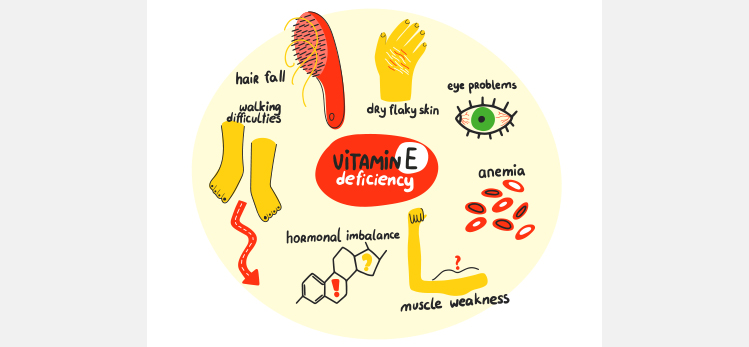Can Vitamin E Help You Prevent Hair Loss?
A popular antioxidant supplement, vitamin e for hair loss, is an effective option. Vitamin E eliminates harmful free radicals responsible for age-related issues and inflammation. It provides an antioxidant blanket in the body, lowering the stress level that triggers hair fall.
Vitamin E is an immunity enhancer that helps repair sun-damaged skin texture. It finds application in treating damaged, frizzy hair strands, restoring the lustrous hair volume, enhancing hair growth and development. Replenished vitamin e for hair loss through diet as supplements help in the improvement of scalp health.
1. Enhanced Scalp Circulation
Vitamin E has antioxidant effects. It helps reduce mental stress, relieving pressure, and enhancing natural circulation. The hair follicles receive essential nutrition required for the natural hair cycle
People having Vitamin E deficiency have poor immunity. It leads to excess stress build-up inside the body, triggering unnatural hair loss. Clinical examinations have proved that Vitamin E helps develop hair follicles from efficient blood circulation and enhanced hair growth.
2. Natural Oil Production
Hair oil is essential to expand hair roots. A sufficient concentration of Vitamin E causes enhanced blood circulation. It helps secrete vital hair oils through open pores (oily feeling on the scalp), spreading from the hair root to the tip.
Hair oils prevent harmful factors like strong sunlight (UV rays), artificial cosmetics, dust, and smoke that damage hair and clogs the pores, blocking oil secretion.
3. Damage-Free Hair
Women are more prone than men to experience rough and damaged hair. Hair damage occurs in the absence of hair oil secretion or clogged pores that make the hair follicles vulnerable to break and shed prematurely.
Application of Vitamin E enriched hair oil helps restore the lustrous volume of hair strands (sufficient hair oil across hair follicles).
4. Reduced Hair Loss
Vitamin E for hair loss cannot stop hair fall (natural phase of hair cycle). It treats and provides support to weak hair strands, making them thick, strong with vital nutrition.
Smooth hair roots stay firmly anchored to the scalp. They resist wear and tear and do not suffer from premature breakage leading to hair fall.
1. Vitamin E enriched diet
Consumption of leafy vegetables, olive, coconut oil, and nuts helps maintain a natural supply of Vitamin E crucial for hair capillary development. Plant-based diets are rich in Vitamin E. If you are a mango lover, it's a luscious treat filled with 10% Vitamin C/servings.
Many people are allergic to nuts. They can draw Vitamin C from vegetable oil and its derivative or consuming kiwis and avocado amongst assorted fruits.
2. Clinical prescription of Vitamin E
If you experience unnatural hair loss, consult a dermatologist to get diagnosed with underlying problems. Prescribed consumption of Vitamin E capsules helps restore the natural hair cycle, reducing abrupt hair fall.
3. Haircare products and Vitamin E
Anti-hair fall shampoos help clean the scalp and opens the clogged pores. Massage with Vitamin E enriched oil (avocado) to nourish the scalp and hair follicles. Apply a hair mask made with Vitamin E enriched ingredients, and wash it appropriately to reduce hair fall.
How to Take Vitamin E for Your Hair
A mature adult requires around 3-4 mg of Vitamin E/day. Here's the list of popular Vitamin E sources;
Gel-based capsules worth 400 mg of Vitamin E dosage prescribed to treat acute vitamin deficiency
Vegetable oils are the most abundant source of vitamin E.
Vitamin E enriched oils treat sunburn and damaged skin (topical application)
Anti-hair fall shampoo and hair restoration oils
This fat-soluble vitamin is highly susceptible to degradation in exposure to air. Cancer patients undergoing chemotherapy often consume vitamin e for hair loss. Consult a dermatologist since an overdose of Vitamin E interferes with specific drug systems.
Conclusion
A natural antioxidant agent, Vitamin E helps maintain smooth and problem-free hair. The deep-rooted nourishment thanks to Vitamin E makes hair follicles fortified from their roots. It makes your scalp dandruff-free and absence of fungal infections responsible for hair fall.
Please consult your dermatologist for further guidance.
Myth Busters HairFall
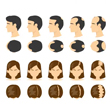
Androgenetic Alopecia - Everything You Need To Know
Have you been experiencing excessive hair fall over a prolonged period of time? It could be an early sign of androgenetic alopecia. It is a hair loss disorder common in both genders and can lead to progressive thinning and even baldness in some patients if not caught and treated early.
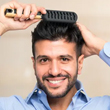
How To Make Hair Grow Faster For Men
A head full of healthy hair is a matter of confidence. Hair has its own mechanism of growing and shedding, and it is when this mechanism is thrown off that growth is hindered. Especially in the case of males, hair growth faces a lot of hiccups that can easily be managed.
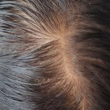
Female Pattern Baldness - Causes & Treatments
Have you suddenly noticed an increase in the number of hair strands on your pillow in the morning? Or is your ponytail getting thinner by day? Well, you might be suffering from female pattern baldness. While that does sound scary, identifying it early on is key to treating this condition effectively. So keep reading to know what this is, how you can identify it, and most importantly, what treatments you can avail of to get your beautiful lustrous hair back.
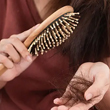
What Are The Reasons For Hairfall?
Almost everyone experiences some amount of hair thinning over the years. Shedding around 50 to 100 single strands of hair per day is considered normal. However, losing more than 150 strands a day, experiencing sudden thinning, or developing circular bald patches on your scalp are reasons for concern. Hair loss occurs when new hair doesn’t grow fast enough to replace the amount of hair you lose daily. Hair can fall due to various reasons, with hereditary hair loss and poor nutrition being the most common hair fall reasons.

Expert Approved Tips For Hair Growth
What can be more debilitating than seeing hundreds of hair strands shedding from your scalp every time you brush your hair? Also, excessive molting occurs during seasonal changes that can be very stressful for you. Although it’s okay to lose between 50-100 strands every day, according to the American Academy of Dermatology, the problem occurs when you start shedding more than normal. But that doesn’t mean you have to feel helpless as there are ways to grow your hair back. Even if you are coping with baldness or alopecia, certain hair growth tips from dermatologists can come to your rescue. Read on to discover how these tips can be your savior when abnormal hair fall problems are in sight.
Trending Videos
+ 3 Sources
LMRC - GGI-CO-A2-DMA-300026127-300026127-WM-J21-282
© 2021 Dr. Reddy’s Laboratories Ltd. All rights reserved.
